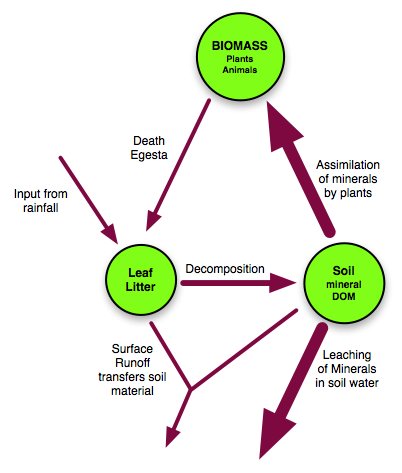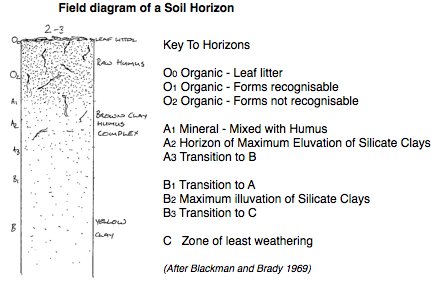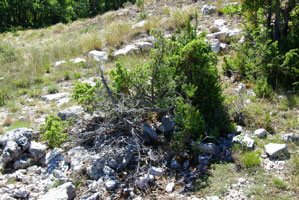3.4. 1: Soil As A System
What is soil?
We tend to take the soil around us for granted, but it is more than just mud or dirt. All the food that we consume depends ultimately upon soil. Plants grow in soil and we either eat plants that grow directly in the soil or animals that have eaten plants.
As well as holding water and mineral nutrients that plants depend upon, soils act as an enormous filter for any water that passes through them often altering the chemistry of that water. Soils store and transfer heat affecting atmospheric temperature, which in turn can affect the interactions between soil and atmospheric moisture.
 Soils are the part of the lithosphere where life processes and soil forming processes both take place.
Soils are the part of the lithosphere where life processes and soil forming processes both take place.
What is soil made from?Soils can be thought of as being made up of four main components.
Mineral particles mainly from the underlying rock
Organic remains that have come from the plants and animals
Water within spaces between soil grains
Air also within the soils grains
It is the exact mix of these four portions that give a soil its character but it is not just these that make a soil what it is. The soils within any environment are the result of a mix of complex soil forming processes. Climate, parent rock material, the shape of the land, the organisms living on and within it and time all contribute to and affect the finished soil.
What does a soil look like?
If you dig a trench in the ground, the side of the trench creates a soil profile, a cross section. This profile changes as it goes down from the surface towards the underlying base rock. It is a record of the processes that have created the soil, its mineral composition, organic content and chemical and physical characteristics such as pH and moisture. Soils scientists classify different soils into groups according to the soil profile. Even though different classification systems have developed in different parts of the world they all show similar patterns.
Soil profiles can be split into distinct horizons or layers. These developed through the movement of water through the soil, which helps to transport soluble minerals and organic matter down to lower layers.
FRACTION
CONSTITUENTS
FUNCTION
Rock particles Insoluble - e.g. gravel, sand, silt, clay and chalk. Soluble- e.g. mineral salts, compounds of nitrogen, phosphorus, potassium, sulphur, magnesium etc. Provides the skeleton of the soil and can be derived from the underlying rock or from rock particles transported to the environment e.g glacial till,Humus, plant and animal matter in the process of decomposition gives the soil a dark colour. As it breaks down it returns mineral nutrients back to the soil. This also absorbs and holds on to a large amount of water
Water Water either seeping down from precipitation or moving from underground sources by capillary action Dissolved mineral salts move through the soil and are also available to plants. Rapid movement of water causes leaching of minerals. Large volumes of water in the soil can cause water logging leading to anoxic conditions and acidification.
Air Mainly oxygen and nitrogen Well-aerated soils provide oxygen for the respiration of soil organisms and plant roots.
Soil organisms Soil invertebrates, micro-organism and large animals Soil invertebrates like worms help to break down dead organic matter into smaller particles. The small particles are then decomposed by soil micro-organisms recycling mineral nutrients. Larger burrowing soil animals help to mix and aerate the soil
Horizons:
 A Horizon: Upper layer. This is where in many soils humus builds up. Humus forms from partially decomposed organic matter and often mixed with fine mineral particles. In normal conditions organic matter decomposes rapidly through the decomposer food web releasing soluble minerals that are then taken up by plant roots.
A Horizon: Upper layer. This is where in many soils humus builds up. Humus forms from partially decomposed organic matter and often mixed with fine mineral particles. In normal conditions organic matter decomposes rapidly through the decomposer food web releasing soluble minerals that are then taken up by plant roots.
Humus that contains a high quantity of alkaline mineral is called mull humus where as humus low in alkaline minerals forms acidic more humus. Water logging reduces the number of soil organisms, which results in a build up of organic matter and can eventually lead to the formation of peat soils.
B Horizon: This is the layer where soluble minerals and organic matter tends to be deposited from the layer above. In particular clay and iron salts can be deposited in this horizon. The process that moves that moves these minerals down through the soil in solution is known as leaching. Soils that form in climates with high rainfall tend to be strongly leached.
C Horizon: This layer is mainly unaltered rock from which the soil forms.
O Horizon: Many soils also contain an upper most layer of newly added organic material such as leaf litter. Where this is present it is counted as the O Horizon
Not all soils contain all three horizons; sometimes only two horizons can be distinguished while in other soils there may be not distinct layering.
Soil formation
 The soil that establishes in any one place depends on a complex set of soil forming factors. Pedologist Hans Jenny defined these factors in 1941. These factors are the climate in which the soil forms, the effect of organisms both in and on the soil, the shape of the land, the material that the mineral part of the soil is made from and time. Jenny summarized these as a functional equation:
The soil that establishes in any one place depends on a complex set of soil forming factors. Pedologist Hans Jenny defined these factors in 1941. These factors are the climate in which the soil forms, the effect of organisms both in and on the soil, the shape of the land, the material that the mineral part of the soil is made from and time. Jenny summarized these as a functional equation:
S = ƒ cl. o. r. p. t. . . .
S = soil, cl = climate, o = organisms, r = relief (land shape, topography), p = parent material, t = time
Jenny left the equation open to add other factors such as human activity.
In this view soil is much more than the weathered remains of rock.
Climate affects the moisture content of soils, the movement of dissolved mineral and soil temperature.
Organisms add dead organic material, which in turn is broken down by soil organisms to release nutrients and carbon. Soil invertebrates create tunnels and mix soil particles. Roots penetrate the soil taking up both water and minerals.
Relief influences the stability of soils. Steep slopes tend to transport material down them, but also drain quickly. Shallow areas allow the deposition of material, but may become waterlogged. Altitude affects temperature and aspect can influences how much sunlight soils receive as well as creating rain shadows in mountain ranges.
Parent material may be either from directly below the soil, bedrock, or may have originated through transport processes such as riverbed load, wind blown less or glacial moraines. This gives the soil its basic chemical composition and physical structure, pH, available nutrients and grain size.
Time alters soils. It allows for weathering of mineral particles, movement and relocation of dissolved portions. Accumulation and decomposition of organic material and erosion and decomposition both require time.